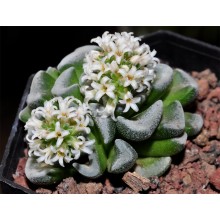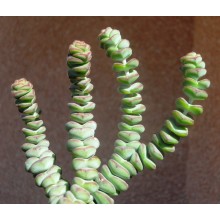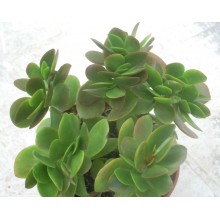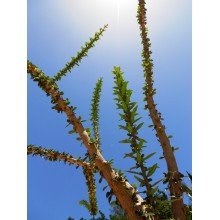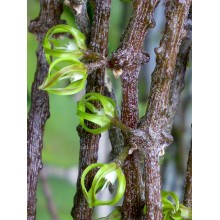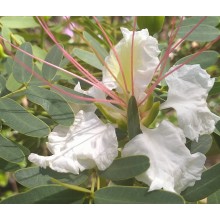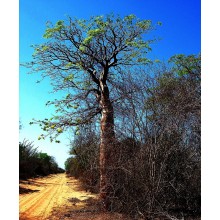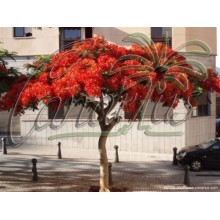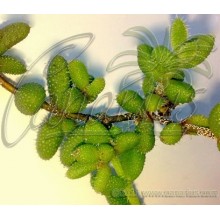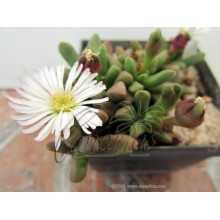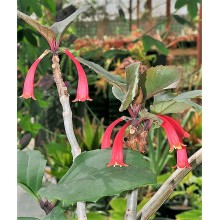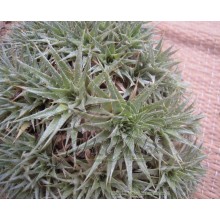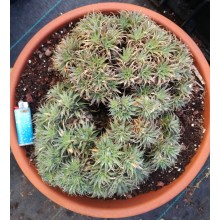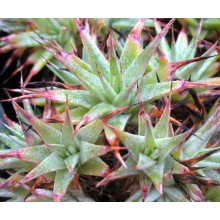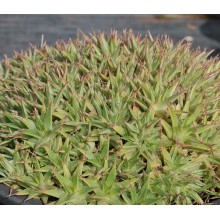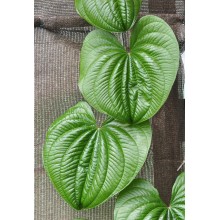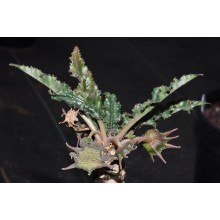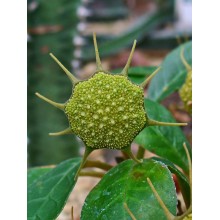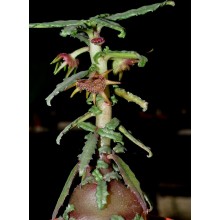Succulente Ci sono 628 prodotti.

I deserti del mondo e le zone secche ospitano le piante più interessanti. Canarius offre una selezione crescente di piante succulente di massima qualità, perché sono coltivate all'aperto, in pieno sole delle Isole Canarie.
I succulente o "piante grasse" sono specie di ritenzione di acqua, adattate alle condizioni di asciutto. Loro accumulano succum (succo, acqua) nelle loro foglie, steli o radici, e spesso mostrano un aspetto robusto e carnoso.
Sotto-categorie
-
Agave
Agave è un genere di piante grasse provenienti dall'America. Alcune specie crescono in zone fredde e possono sopportare un forte gelo, mentre altri vivono in climi tropicali. Alcuni sono piccoli nani e alcuni sono giganti, fino a 2 o 3 m di larghezza.
Le agavi resistenti al freddo possono creare un effetto esotico nel vostro giardino. Le specie agave fanno bella compagna di palme o cactus. Le agavi variegate sono incredibilmente ricercati dai collezionisti. Il nostro negozio web offre una selezione in continua evoluzione delle specie. Spediamo piante a radice nuda, se non diversamente specificato.
-
Aloe, Gasteria & Haworthia
Aloe, Gasteria e Haworthia sono tre generi correlate, comprese centinaia di piante succulente. Sono tutti facilmente coltivate in vaso. Alcuni si adattano a bassi livelli di luce di condizioni interne e possono essere coltivate come piante da appartamento.
- Aloe è un genere di circa 400 specie, originarie di Africa, Arabia e Madagascar. I aloe piccoli o nani stanno diventando particolarmente popolare in climi più freddi in quanto possono essere presi in casa durante i mesi più duri.
- Gasteria comprende circa 80 specie endemiche in Sud Africa, conosciuti per le loro foglie spettacolari che sono lucide, screziati e ruvidi. Fioriscono in primavera-estate con lunghe punte di piccoli fiori arancioni. Alcune specie sono talmente variabile che offriamo cloni particolari di località specifiche.
- Haworthia è un genere endemico in Sud Africa con circa 70 specie e un certo numero di sottospecie locali, varietà e forme. Le foglie sono spesso banded, punteggiati, punteggiato, o semi-trasparente e mostrano ampie variazioni.
-
Crassule
Questa è una nuova e crescente sezione di specie della famiglia Crassulaceae. Ci sono circa 1.400 specie in 33 generi et la loro distribuzione è in tutto il mondo, ma si presentano più nell'emisfero Nord e Sud Africa, in particolare in ambienti asciutti. Qui si possono acquistare piante sani, indurito dal sole, coltivati nelle isole Canarie e spediti a casa tua.
-
Mesembriantemi
Questo gruppo di piante del deserto è chiamato Mesembriantemi perché appartengono a una famiglia botanica precedentemente denominata Mesembryanthemaceae. Ci sono quasi 2.000 specie, che si trovano principalmente in Africa del sud, con adattamenti estremi agli habitat secco. Alcuni sono chiamati "pietre vive", perché sembrano come ciottoli. Molti sono facili da coltivare e il loro bisogno principale è pieno sole. Alcuni sono difficili perché crescono nelle aree veramente estreme.
Il nostro Web Shop offriamo piante sane coltivate al sole, con foglie compatte e colorate. Alcune piante sono venduti come talee, e altri come piante radicate, di almeno due anni. -
Sansevieria
Recentemente assegnato alla famiglia Asparagaceae, il genere Sansevieria conta circa 70 specie, quasi tutti nativi in Africa, Arabia e Madagascar. Erbe perenni adatti per gli habitat secchi con foglie rigide, succulente, la loro lunghezza varia da pochi centimetri a 2 metri. Sansevieria trifasciata e le sue numerose cultivar sono tra le piante d'appartamento più apprezzati, popolarmente chiamata la lingua di suocera. Una pianta ben coltivata di solito produce un picco di molti fiori bianchi, riccamente profumati e poi bacche arancioni. Anche le specie più rare sono resistenti ad abbandono, a condizione di tenerli dal gelo in inverno e sole cocente in estate.
-
Hoya
Le Hoyas sono rampicanti, dai fiori esotici e spesso vistosi. Provengono dalle foreste pluviali in Asia e Oceania. La maggior parte delle specie vive bene a mezz' ombra e si adatanno a vivere in casa come piante da appartamento. Sono ideali per cesti e tralicci. Tollerano un paio di settimane di siccità, ma sono sensibili al gelo e freddo. Molte hoya i sono facili da far crescere e fiorire, mentre alcune sono difficili e rare.
-
Asclepiadaceae
Le Asclepiade, o Asclepiadoideae, sono una sottofamiglia delle Apocynaceae, che annoverano circa 2900 specie diverse. Tra queste si trovano molti fusti privi di foglie ma anche erbe perenni, arbsuti, liane e, raramente, alberi. Producono fiori molto belli, dato il complesso sistema di impollinazione. Molte specie producono un odore insolito, spesso associato a quello di una carogna, la cui funzione è quella di attrarre le mosche che poi andranno a impollinare i fiori. -
Caudiciformi
Queste piante, dette anche pachicauli, sono tipiche delle zone aride. Producono un tronco insolitamente grosso e sproporzionato, detto caudice (a volte anche tubero), spesso con ramificazioni. Il caudice può essere anche nascosto sottoterra, ma nella maggior parte dei casi ha sviluppo verso l'alto, dando luogo ad alberi dalla forma spettacolare. I caudiciformi più grandi sono i baobab. -
Altre succulente
Qui troverete tutte quelle specie di piante del deserto che non sono inclusi nella propria categoria. Metteremo qui tutte le piante provenienti da famiglie inusuali, diversi da Agavi, Aloe, Crassulaceae, Sansevieria, Mesembriantemi, Epiphytic cacti, etc.
-
Crassula x 'Celia'
Crassula x 'Celia'
This hybrid was made by crossing two compact species of Crassula, in order to obtain a cute, "living-stone" plant, resmbling indeed a Titanopsis.
16,80 € -
Crassula x Jade Necklace
Crassula x Jade Necklace
Beautiful ornamental cross of crassulas, resembling a "Jade Necklace", with jade-green, red-edged leaves and rather large, pink-tinged flowers
10,60 € -
Crassula x Pretoria Hybrid
Crassula x Pretoria Hybrid
NEW ! - This hybrid turns hot red in full sun. It came from Pretoria and it probably has "blood" of Crassula cultrata
10,50 € -
Crescentia mirabilis
Crescentia mirabilis
Shrub or small tree with spreading stems, and small ovate leaves, just like some Didieraceae from Madagascar. Flowers are large and weird, bat pollinated. It is a relative of the common Calabash Tree, adapted to harsh coastal conditions.
72,00 € -
Cynanchum luteifluens
Cynanchum luteifluens
Green climbing stems, often streaked and dotted with silvery wax. It bears beautiful flowers, lime yellow with a pure white centre. This "caustic vine" is native to Madagascar and its former name was Cynanchum decaisneanum.
21,30 € -
Cynanchum marnierianum
Cynanchum marnierianum
Fascinating hanging plant from Madagascar. Stems are rough and thin. New branches are green and they get browner as the grow. Its beautiful flowers resemble small green Chinese lanterns.
17,20 € -
Delonix decaryi
Delonix decaryi
1-2 year old seedling, H:40-70 cm. This is one of the few species of Delonix that grows as a "bottle-tree" , like a baobab. It is native to the dry South of Madagascar, where it grows together with other succulent plants and caudiciforms. Adult "bottle-trees" are very beautiful when they get covered of plenty of flowers.
45,00 € -
Delonix floribunda
Delonix floribunda
Another interesting Delonix from Madagascar. It is very adaptable and can attain anything from 3 to 12 m in height. Flowers lack petals but they are very beautiful, with lots of golden stamens shown when the tree is still leafless. We grew some plants in 35 cm pots and they started blooming beautifully after about 5 years, when they were just 1.5 m tall.
72,00 € -
Delonix regia
Delonix regia
This is the dream tree of the tropics, often considered the most beautiful of all flowering trees. Commonly called Royal Poinciana or Flamboyant. Its showy red flowers are the essence of the tropics.
46,20 € -
Delosperma echinatum
Delosperma echinatum
NEW ! - Three unrooted cuttings of 6-8 cm. beautiful, unusual succulent leaves, densely covered in glossy translucent "hairs". These are visible adaptations to catch moisture from fogs.
10,90 € -
Delosperma esterhuyseniae
Delosperma esterhuyseniae
Cont.= 6 cm. Compact, clumping plant, 6-15 cm in diameter, with a central rootstock. Dark green or reddish leaves and white, 1,5 cm flowers. Native to the Uniondale district of the W. Cape of South Africa. Winter-growing but enjoys some summer rain.
10,40 € -
Deuterocohnia brevifolia ssp. chlorantha
Deuterocohnia brevifolia ssp. chlorantha
Clump of 6-10 heads - Small, terrestrial, cushion-forming plant species. It is probably one of the cold hardiest of the bromeliads.
31,00 € -
Deuterocohnia brevifolia ssp. chlorantha –LARGE
Deuterocohnia brevifolia ssp. chlorantha –LARGE
Clump of >30 heads. 12 cm diameter ! - Small, terrestrial, cushion-forming plant species. It is probably one of the cold hardiest of the bromeliads.
151,30 € -
Dorstenia foetida
Dorstenia foetida
Dorstenia foetida is small and "palm-like" in shape. Its caudex has a green-and-grey bark nicely dotted with leaf scars. Arching leaves form a rosette on the top of the stem.
10,80 € -
Dorstenia hildebrandtii crispa
Dorstenia hildebrandtii crispa
This is the most beautiful form of the widespread Dorstenia hildebrandrii. It is cute in all its stages, with a rounded, smooth swollen base which can be green to maroon.
17,40 €
Al momento ci sono pochi prodotti in questa categoria Succulente

























